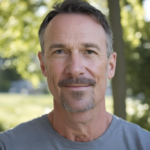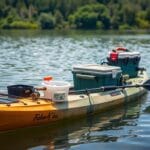Explore Canada's Ultimate Fishing, Hunting, and Wildlife Adventures

Key Takeaways
1. Fishing from a pier provides benefits such as access to deeper waters and a wider variety of fish species.
2. Essential equipment for successful pier fishing includes fishing rods, reels, lines, tackle box, hooks, and sinkers.
3. Techniques for pier fishing include casting, retrieving, jigging, bottom fishing, lure fishing, and live bait fishing.
4. Factors to consider when selecting the best pier for fishing include fish species, water conditions, accessibility, and local regulations.
5. Bait selection for pier fishing can include live bait such as shrimp, crabs, and worms, as well as artificial baits like lures and jigs.
Are you ready to take your fishing game to the next level?
If so, it’s time to master the art of pier fishing. Fishing from a pier provides several benefits that can enhance your fishing experience, such as access to deeper waters and a wider variety of fish species.
This comprehensive guide and tips article will cover everything you need to know to become a successful pier fisherman. From the essential equipment needed for a successful fishing trip to techniques for pier fishing and the best spots to catch fish, we’ve got you covered.
We’ll also discuss bait selection, pier fishing rigs, and provide tips and tricks for success. Additionally, we’ll include safety precautions that should be taken while pier fishing. Once you’ve caught your fresh catch, we’ll provide tips for cleaning and cooking it to perfection.
It’s important to be aware of fishing regulations and permits when pier fishing, and we’ll discuss those as well. To wrap up, we’ll address frequently asked questions about pier fishing to give you a helpful resource at your fingertips.
So, let’s dive in and learn how to master the art of pier fishing!
Table of Contents
Equipment for Successful Pier Fishing
Pier fishing requires specific equipment to be successful. Some of the essential gear needed for pier fishing includes:
| Equipment | Description |
|---|---|
| Fishing Rods | A long, flexible rod used to cast and reel in fish. |
| Reels | A device mounted on the rod used to spool and retrieve fishing line. |
| Lines | The cord used to connect the reel to the hook and bait. |
| Tackle Box | A container used to store fishing tackle and accessories. |
| Hooks | A curved device used to catch fish, available in different sizes and styles. |
| Sinkers | A weight used to sink the bait and hook to the desired depth. |
It’s important to choose gear based on the type of fish you plan to catch. For example, a light rod and reel are suitable for smaller fish such as panfish, whereas a larger rod and reel are required for bigger fish such as striped bass.
Additional Equipment
In addition to the basic gear, there are a few more items that can be helpful for pier fishing:
- Plastic bucket for storing catch or bait
- Fishing pliers for removing hooks
- Fishing net for landing bigger fish
- Fishing vest with multiple pockets for storing gear
With the right equipment in hand, you’ll be well on your way to becoming a successful pier angler.
Disclosure: When you purchase a service or a product through our links, we sometimes earn a commission, at no extra cost to you.
Techniques for Pier Fishing
Pier fishing requires a unique set of skills and techniques compared to other types of fishing. In this section, we’ll cover some of the most effective techniques for pier fishing to help you reel in that big catch.
Casting
When pier fishing, it’s essential to master the art of casting. The most common casting method used on piers is the overhead cast. The key is to keep your elbows close to your body, use your wrist to flick the line, and aim for the spot you want to fish. It’s crucial to practice your casting technique beforehand to avoid getting your line tangled with other anglers.
Retrieving
Retrieving is the act of bringing in the line with the bait or lure. It’s essential to retrieve the line at a constant speed and keep the line taut to feel any bites. You can also add a slight jigging motion to your retrieval to make your bait look more attractive to fish.
Jigging
Jigging involves raising and lowering the fishing line to create a vertical motion that mimics a live bait’s movement. This technique is particularly effective when targeting bottom-dwelling species like flounder and halibut.
Bottom Fishing
Bottom fishing involves letting your bait sink to the bottom and waiting for a fish to bite. You can use a Carolina rig or fish-finder rig to keep your bait near the bottom and feel any bites. Bottom fishing is particularly effective for catching species like redfish and black drum.
Lure Fishing
Lure fishing involves using artificial lures that mimic live bait. Lure fishing is effective for targeting species like trout, snook, and striped bass. It’s important to select the right lure for the species you’re targeting and use a retrieval technique that mimics the natural movements of the bait.
Live Bait Fishing
Live bait fishing is the act of using live bait to lure in fish. Shrimp and crabs are popular live bait options, but you can also use worms, squid, or other small fish. Live bait fishing is particularly effective for catching species like tarpon, snapper, and catfish.
By mastering these techniques, you’ll increase your chances of catching fish when pier fishing. Remember to always practice proper pier fishing etiquette and follow local regulations to ensure a successful and enjoyable fishing experience.
Best Spots for Pier Fishing
Fishing from a pier is an excellent way to catch a wide variety of fish in a controlled and accessible environment. However, not all piers are created equal when it comes to fishing. Choosing the right pier can make a big difference in your chances of catching fish.
Here are some factors to consider when selecting the best pier for fishing:
| Factor | Description |
|---|---|
| Fish Species | Look for piers known to have a high concentration of the fish species you are targeting. Research local fishing reports or talk to other anglers to find the best spots. |
| Water Conditions | The current, tide, and water clarity can all impact fishing success. Piers located in areas with strong currents or murky water may not be the best choice. |
| Accessibility | Choose a pier that is easily accessible for you and your equipment. Some piers require a long walk or have limited parking. |
| Regulations | Be aware of local regulations regarding fishing on piers. Some piers may have restrictions on the type of gear allowed or the hours of operation. |
With these factors in mind, here are some popular piers known for their excellent fishing opportunities:
- Santa Monica Pier in California
- Jacksonville Beach Pier in Florida
- Galveston Fishing Pier in Texas
- Ocean City Pier in Maryland
- Navarre Beach Fishing Pier in Florida
Conclusion
Selecting the right pier for fishing is crucial for a successful pier fishing experience. Keep in mind the fish species, water conditions, accessibility, and local regulations when choosing a pier. By following these tips and selecting the right pier, you can increase your chances of catching the fish of your dreams.
Bait Selection for Pier Fishing
Choosing the right bait is crucial to successfully catching fish from a pier. The type of bait used largely depends on the species of fish you are targeting. Some popular options for pier fishing include live bait and artificial baits.
Live Bait
Live bait is often considered the most effective bait for pier fishing. Some common live bait options include shrimp, crabs, and worms. Before using live bait, it’s important to check local regulations and restrictions on using live bait in the area you will be fishing.
| Bait Type | Target Fish Species |
|---|---|
| Shrimp | Flounder, redfish, trout, sheepshead |
| Crab | Sheepshead, black drum, redfish, pompano |
| Worms | Redfish, trout, whiting, catfish |
Artificial Baits
Artificial baits like lures and jigs are another option for pier fishing. They come in a variety of sizes, colors, and shapes, and can mimic the movement and appearance of live bait. When selecting an artificial bait, it’s important to consider the fish species you are targeting and the water conditions.
| Bait Type | Target Fish Species |
|---|---|
| Soft Plastic Lures | Trout, redfish, flounder, snook |
| Jigs | Pompano, redfish, trout, sheepshead |
| Spoons | Mackerel, bluefish, spanish, trout |
When using artificial baits, it’s important to manipulate them in a way that mimics the movement of live bait. This can be achieved through various techniques like twitching, reeling, and jerking.
Overall, selecting the right bait and using proper techniques can significantly improve pier fishing success.
Pier Fishing Rigs
Pier fishing requires specialized rigs that can withstand the strong currents and waves.
Here are some of the most commonly used rigs:
| Rig | Description |
|---|---|
| Fish-Finder Rig | This rig is ideal for fishing in deeper waters and works well with live bait. The line is threaded through a sliding sinker and a bead before being tied to a barrel swivel. The swivel is then tied to a leader line with a hook at the end. |
| Carolina Rig | The Carolina rig works well for bottom fishing and is great for catching flounder or redfish. The rig consists of a sliding egg sinker, bead, barrel swivel, leader line, and hook. |
| Dropper Rig | This rig is perfect for catching multiple fish at once. It consists of a leader line with multiple hooks tied at different lengths. It allows for several baits to be used at once, increasing the chances of catching fish. |
It’s important to set up the rigs properly to ensure they function correctly. Remember to adjust the weight of the sinker based on the strength of the current and the depth of the water.
Dropper Loop Knot
One important knot to learn when making rigs is the dropper loop knot. Follow these steps to create the dropper loop knot:
- Create a small loop in the middle of the line.
- Hold the loop in place with your fingers and make a number eight with the two lines.
- Take the end of the line and pass it over the top of the loop.
- Pass the end of the line through the loop from the bottom.
- Next, pass the line through the top opening of the number eight.
- Pull the knot tight and trim the excess line.
With the right rigs, pier fishing can be a successful and enjoyable experience.
Tips and Tricks for Pier Fishing
Mastering pier fishing requires more than just the right gear and techniques. Experienced anglers know that there are many variables that can impact your success on the pier.
Here are some additional tips and tricks to help you maximize your pier fishing experience:
Timing is key
The time of day or night you choose to fish can make a big difference in the number and size of fish you catch. Many species are more active during certain times of the day, such as dawn or dusk. Pay attention to the tides and plan your fishing around incoming or outgoing tides, as this can also impact fish behavior.
Be prepared for changing weather conditions
The weather can change quickly, and it’s important to be prepared for anything when you’re fishing on a pier. Bring appropriate clothing and footwear, even if the forecast looks sunny and warm. A sudden rainstorm or drop in temperature can make for a miserable fishing experience if you’re not prepared.
Handle fish with care
It’s important to treat fish with respect and handle them with care, whether you plan to release them or keep them for food. Use appropriate gear to minimize harm and stress to the fish, and avoid squeezing or gripping them too tightly. If you plan to release the fish, do so quickly and gently to minimize harm.
Be aware of other anglers
Piers can get crowded, especially during peak fishing times. Be respectful of other anglers and their space, and avoid casting over other lines. If you’re using live bait, try to keep it contained within your designated area to avoid drawing other fish (and anglers!) to your spot.
Know the local regulations
Before you hit the pier, make sure you know the local regulations and permit requirements for fishing in that area. This can vary by location, and failing to comply can result in fines or other penalties. Knowing the rules and regulations also helps ensure that you’re fishing in a sustainable and responsible manner.
Safety Precautions for Pier Fishing
Pier fishing can be a fun and rewarding activity, but it’s important to prioritize safety while on the pier.
Follow these safety tips to ensure a safe and enjoyable experience:
- Dress appropriately: Wear comfortable clothing and sturdy, non-slip footwear to prevent slips and falls on wet surfaces. Protect your skin from the sun with sunscreen and a hat.
- Be aware of fishing lines: Watch for fishing lines and be cautious not to get tangled in them. Be sure to cast your line away from other anglers on the pier.
- Handle fish with care: If you catch a fish, handle it gently and with wet hands to avoid injuring it. Release it back into the water as quickly as possible.
- Follow local regulations: Be familiar with the fishing regulations in your area and adhere to them. Respect any posted rules on the pier and always obtain the necessary permits before fishing.
- Stay alert: Keep a close eye on the water conditions and weather, and be aware of any changes in the environment. If you notice sudden changes in the weather or water conditions, consider leaving the pier for safety reasons.
“It’s important to prioritize safety while on the pier. Follow these safety tips to ensure a safe and enjoyable experience.”
By following these safety precautions, you can ensure that your pier fishing experience is not only enjoyable but also safe. Remember to always prioritize safety and be respectful of others on the pier.
Cleaning and Cooking Your Catch
Catching fish from a pier can be a fun and rewarding experience. After a successful day on the pier, it’s important to properly clean and cook your catch to ensure a delicious and safe meal. Here are some tips and techniques for preparing fresh catch:
Cleaning Your Fish
Before you begin cleaning your fish, make sure you have a sharp fillet knife, cutting board, and a bowl of clean water.
Start by removing the scales using a scaler or the back of a knife. Next, cut off the head with a clean cut behind the gills.
Then, make a cut along the belly from the anus to the base of the head. Remove the guts and rinse the cavity thoroughly with water. Finally, fillet the fish by running the knife along the backbone, making sure to remove all bones.
Cooking Your Fish
There are many ways to cook fish, but grilling, frying, and baking are some of the most popular techniques. When grilling, preheat the grill to medium-high heat and brush the fillets with oil or butter to prevent sticking.
Place the fillets on the grill and cook for 4-5 minutes on each side, or until they are cooked through.
When frying, heat oil in a frying pan over medium-high heat. Season the fillets with salt and pepper, and coat them in flour or breadcrumbs.
Place the fillets in the pan and fry for 2-3 minutes on each side, or until they are golden brown and crispy.
When baking, preheat the oven to 375°F. Brush the fillets with oil or butter and season with salt and pepper. Place the fillets in a baking dish and bake for 15-20 minutes, or until they are cooked through.
Additional Tips
When handling fish, always wash your hands thoroughly before and after cleaning the fish. Use a sharp fillet knife to make clean cuts and avoid bones. When selecting fish for cooking, look for firm, brightly-colored fillets.
To add flavor to your fish, try marinating the fillets in your favorite marinade for a few hours before cooking. And lastly, don’t forget to serve your cooked fish with a side of your favorite vegetables or salad for a complete and healthy meal.
Fishing Regulations and Permits
It is important to be aware of and follow fishing regulations and permit requirements when pier fishing. Failure to comply with regulations can result in fines or legal consequences.
Regulations may vary depending on the location of the pier and the type of fish being caught. It is advisable to obtain information on local fishing regulations before heading to the pier.
Where to Find Fishing Regulations
Fishing regulations can be found on government websites, such as the website of the state’s fish and wildlife agency. Regulations may also be available at local tackle shops or bait and tackle stores. It is essential to review and understand these regulations before fishing.
Obtaining a Fishing Permit
Different states and locations have their own permit requirements. Some piers may require a permit, while others may not. It is important to determine whether a permit is required and obtain one in advance.
Permits can usually be obtained online or at local tackle shops. In some cases, permits may also be available at the pier itself. It is advisable to carry the permit while fishing on the pier.
Consequences of Non-Compliance
Failure to comply with fishing regulations and permit requirements can result in fines or legal consequences. The fines may depend on the nature of the violation and the location of the violation.
In addition to fines, non-compliance can also lead to the confiscation of fishing gear, vehicles, or boats. It is important to prioritize safety and follow regulations when pier fishing.
FAQ about Master the Art of Pier Fishing
Here are some frequently asked questions about pier fishing:
Q: What is the best time to go pier fishing?
A: The best time for pier fishing depends on the tides and the time of day. Typically, the best time to fish is during high tide or when the tide is starting to come in. Early morning and late afternoon are also good times to fish when the sun is not too bright.
Q: What is the most effective bait for pier fishing?
A: The most effective bait for pier fishing depends on the species of fish you are targeting. Shrimp, crab, and worms are popular live baits, while lures and jigs are popular artificial baits. It’s important to match the bait to the species of fish you are trying to catch.
Q: What should I wear when pier fishing?
A: It’s important to wear comfortable and weather-appropriate clothing when pier fishing. You should wear light-colored clothing to reflect the sun and a hat to protect your face from the sun. It’s also important to wear shoes with good traction, as the pier can be slippery.
Q: Is it safe to fish from a pier?
A: Pier fishing can be safe if you follow certain precautions. Always be aware of the fishing lines around you and avoid casting near other anglers. It’s also important to handle fish safely and avoid touching their gills or eyes. Be sure to wear proper clothing and footwear to prevent slips and falls.
Q: Do I need a fishing permit to fish from a pier?
A: It depends on the location and local regulations. Some piers require a fishing permit, while others do not. It’s important to research the local fishing regulations and obtain any necessary permits before fishing from a pier.
Q: Can I eat the fish I catch from a pier?
A: Yes, you can eat the fish you catch from a pier if they are within the legal size limit and safe to eat. Before cooking the fish, be sure to clean them properly and remove any guts or scales. It’s important to research and follow local fishing regulations regarding fish consumption.
Resources and External Links
Here are some additional resources and external links that can help you learn more about “Master the Art of Pier Fishing”:
Articles:
- Pier Fishing Tips for Beginners (Updated 2023) – FishingBooker
- Mastering The Art Of Pier Fishing: Insider Tips And Techniques! – Riggle Reviews
- No Boat, No Problem: A Beginner’s Guide to Pier Fishing Etiquette – Free Range American
- Unlock the Secrets: How to Make a Gaff for Pier Fishing Like a Pro – Anglers Advantage Guide Service
These resources provide additional information and insights about “Master the Art of Pier Fishing”.
